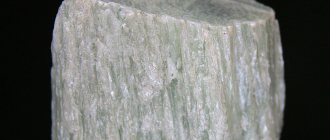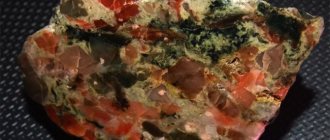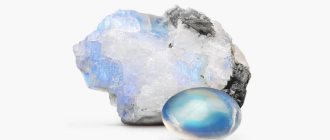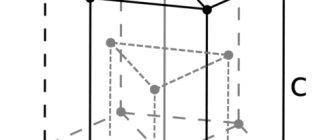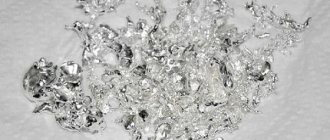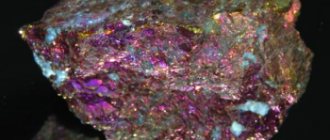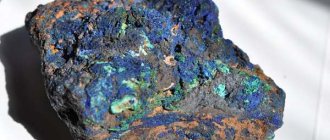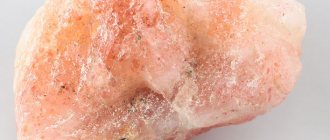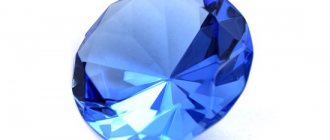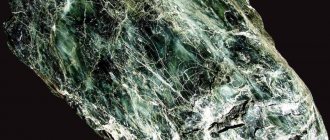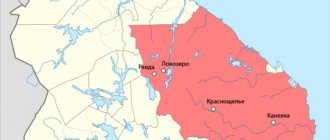Plagioclases are an isomorphic series between sodium-alkaline (albite, analbite, monalbite) and calcium-alkaline earth (P-anorthite, I-anorthite) end members, in which, simultaneously with the replacement of Na by Ca, an equivalent part of Si is replaced by Al. The composition of plagioclase is usually characterized by its number corresponding to the content of the anorthite component (An0-An100).
origin of name
The name of the mineral comes from the Greek “plagios” - oblique, inclined and “oasis” - fracture, emphasizing that the angle between the cleavage planes (001) and (010) is significantly different from straight (from 86°24′ in albite to 86°50′ in anorthitis).
Plagioclase. Adular. The natural intergrowth of crystals is a quadrangle
The English name for plagioclases is Sodium-calcium feldspars (plagioclases)
Plagioclase formula
(Na,Ca)[(Al,Si)4O8]
Varieties
According to the chemical composition, the plagioclase series is traditionally divided into albite (An0-10), oligoclase (An 10-30), andesine (An30-50), labradorite (An 50-7o), bytownite (An10-90) and anorthite (An90-100 ).
Among homogeneous plagioclases, according to their structural state, high-temperature and low-temperature series are distinguished. The crystal structures of the extreme members of the series differ significantly: in albite, NaAlSi3O8. Si and Al are ordered along 4 nonequivalent positions; in anorthite CaAl2Si2O8 they alternate in the Si,Al framework and are strictly ordered, which leads to doubling of the unit cell along the c axis, 7x2=14A (the differences in the high-temperature body-centered structure are determined by the displacement of Ca atoms). In the intermediate members of the series, albite 7 A domains alternate in different proportions with anorthite 14 A domains (the X-ray reflections of the latter, responsible for cell doubling, appear in them as weak satellite reflections). The structure of low-temperature albite is preserved only up to composition An5, expanding the region of oligoclase, which makes it possible to distinguish compositions An5-10 as albite-oligoclases. As in alkali feldspars, phase decomposition phenomena have been established in plagioclases. Three regions of decomposition are distinguished: peristerites (in the region of albite-oligoclase, An2-An15, with the formation of plates with a thickness of X = 1000-5000 A along the (081) plane, close to (010), corresponding in composition to albite and oligoclase An25, sometimes An20-35), the Böggild region (in andesine-labradorite, An48-An58, with the formation of two phases of “e”-plagioclases An45 and An50-60) and the Huttenlocher intergrowth region (in labradorite-bytownite, An10-An90, with the formation of plates X = 125-850 A of “e''-plagioclase An65 and I-anorthite). Structural and subsolidus phase relationships in plagioclases are complex, debatable, and interpreted ambiguously. Decayed plagioclases often exhibit iridescence. Albite-oligoclases and oligoclases with a blue or milky-white pearl tint, by analogy with K,Na-feldspars, are distinguished as moonstones. Blue and blue-green iridescence is characteristic of Labrador. Aventurine albite-oligoclases and labradorite, which exhibit a yellow-orange or, respectively, reddish-pink, crimson tint, are distinguished as sunstones.
Crystallographic characteristics
Syngony. Triclinic
Aggregates. The crystals are the same in appearance as those of potassium feldspars.
Plagioclases often form irregular grains embedded in the rock, granular aggregates, sugar-like masses, and sometimes druses (albite). The formation of polysynthetic (multiple repeating) twins is typical - the crystal consists of many very thin (hundredths - tenths of a millimeter) lamellar crystals.
Physical properties of plagioclases
Optical
- Color white, yellow, pink, green, black. Often colorless. The characteristic colors of iridescence are white, blue, yellowish-white (oligoclase-peristerite, belomorite, labradorite) or golden color caused by inclusions of hematite flakes (aventurine oligoclase, sunstone).
- The line is colorless.
- Glassy shine on cleavage planes. Translucent around the edge.
- Transparency. Transparent or translucent.
Mechanical
- Hardness 6-6.5.
- Density from 2.62 (albite) to 2.76 (anorthite).
- Cleavage according to (001) is perfect, according to (010) clear, according to (110) weakly expressed. The cleavage is perfect in two directions (at an angle of about 860). The angle between the cleavage planes differs from the straight line by 3.5 - 40. The name of the mineral is also associated with this property - from the Greek “plagioclase” - obliquely splitting (unlike potassium feldspars).
- The fracture is stepped, uneven.
- Fragile.
Chemical properties
Unlike all other feldspars (except for Celsian), anorthite dissolves relatively easily in HCl with the formation of gelatin-like silicic acid, bytownite - worse, labradorite - poorly. Albite, oligoclase and andesine dissolve only in HF. All plagioclases are also decomposed by molten soda Na2CO3.
Other properties
IR spectroscopy is used to determine the composition of plagioclases and their thermal history. The characteristic bands are A in the wavelength region 15.4-16.7 mmk and B in the region 18.2-20.0 mmk (in Russia, where frequencies are usually used, this corresponds to m1 = 650-600 cm-1 v2 = 550 -500 cm-1). According to the absorption band v, it depends on the composition of plagioclases, varying from 649 cm-1 in albite to 620 cm-1 in anorthite in the low-temperature series, and on the degree of their order.
Melting points vary from 1100 (albite) to 1550° (anorthite).
Diagnostic signs
The chemical composition of plagioclases can be determined by their refractive indices, which are practically independent of the structural state. The np indicator is diagnostic for the entire plagioclase series, the ng and nm indicators are for plagioclases of composition An 20-100.
The chemical composition and structural state of plagioclases can be determined using the “Slemmons diagram” (with a known composition, the degree of order can be determined and vice versa).
Plagioclases differ from similar potassium feldspars by the mutual arrangement of cleavage planes at an angle of 86 - 870. However, such a slight deviation from the right angle characteristic of potassium feldspars is not visually noticeable. In this regard, it is macroscopically possible to determine only whether the mineral belongs to the feldspar group. In terms of external features, all plagioclases are similar to each other and are usually not separated macroscopically. The only exception is Labradorite - dark gray in color with very characteristic blue iridescence (irridescence) on the cleavage planes
Practical use
Due to its properties, the stone is used by jewelers who make jewelry from it. Minerals are also important for collectors.
- Jewelers prefer albite, which is easy to polish. Thus, specialists create jewelry that has a long service life without losing its original properties. The mineral is used as fertilizer in agriculture. Thanks to the components included in its composition, plants grow faster.
- Labradorite is valued as a finishing material and is used to decorate interiors. Among the advantages of stone, it is worth highlighting its high wear resistance and density. In addition, it is used in the design of monuments.
- During the weathering process, high-quality clay is formed, which is soon used for the production of porcelain tableware and ceramics. This makes the products stronger and more durable.
- Given the absorbent properties of clay, it is used in the manufacture of cosmetics.
Therapeutic effect
The stone has a positive effect on the digestive organs. Its benefits for the kidneys, liver and the body as a whole have also been noted. It is considered a prophylactic during colds.
You shouldn't wear it regularly. It is enough to adhere to the following scheme. It is applied to the sore spot for several minutes (10 to 20). At the same time, prescribed medications are taken. It is important to relax and lie down.
Magical influence
Astrologers have proven the fact that the stone is an excellent conductor between the Moon and the Sun. Therefore, plagioclase is used in magical rituals.
It helps relieve stress and reduce nervous tension.
The amulet is recommended to be worn by people with increased excitability who pay attention to other people's opinions. But the amulet consists of two samples, since the power of one stone is small. Regular wearing of the mineral helps to gain mental clarity and wisdom.
In addition, it should be worn by travelers who will be protected from dangers and troubles on the road.
In China, they believe that albite allows people to achieve harmony with the environment.
To nourish a solar stone, it must be placed under the rays of the Sun and removed at night. For lunar plagioclase the opposite is true.
It has been noticed that the mineral has a positive effect on the home. To protect it from negativity, the stone is hung at the entrance, on the outside.
Influence on Zodiac signs
This mineral is suitable for all zodiac signs, although it belongs to the element of Water.
Origin and location
Various: igneous (acidic - in acidic rocks, intermediate - in intermediate rocks, basic - in basic rocks, albite - in alkaline rocks), pegmatite (giant oligoclase segregations are found), hydrothermal (albite only), metamorphic, exogenous - during diagenesis ( albite).
Plagioclases are the main rock-forming minerals of igneous (volcanic and intrusive) rocks, felsic to mafic, metamorphic and metasomatic formations, pegmatites and hydrothermalites. Formed in sedimentary rocks. They are characteristic minerals of the Moon. They are often formed together with potassium, potassium-sodium and barium feldspars. Whether plagioclase belongs to a high-temperature or low-temperature series is determined by the “Slemons diagram”.
Breed classification
The range of this breed is quite extensive, it consists of the following orders:
- Labradors. The main component of igneous rock with minimal silica content. Specimens include inclusions of ilmenite, titanium and magnetite. The main deposit of San Polo.
- Albites. Representative of the silicate class. The most common and in demand. It has a huge color background, ranging from pale blue and gray-yellow to almost transparent (colorless).
- Anorthitis. A very fragile stone with a pronounced glassy luster. It is characterized by transparency and glassy luster, which disappears when weathered.
- Andesites. Rock formations with crystal cleavage with an unusual tabular appearance. Characterized by transparency and shine. Most often formed in igneous rocks.
- Oligoclases. Tabular formations of crystals in red, yellow or gray colors. The second name is sun stone. Widely used in jewelry.
- Bytovnites. It is very difficult to find this mineral in the form of crystals. Most often these are isomorphic anorthosites.
Mineral Change
Plagioclases in the weathering crust are less stable than potassium feldspars and change before it. Albite is the most stable, calcium plagioclases the least stable. With hypergene alteration of albite-oligoclase and oligoclase, halloysite is formed, after andesine, labradorite and bitownite - montnorillonite, less often halloysite (unlike potassium feldspars, after which kaolinite develops). Halloysite replaces oligoclase without the formation of any intermediate phases, growing on it epitaxically in the same orientation as kaolinite on microcline. Initially, lamellar crystallites of halloysite are formed, from which radiating rays extend from the edges, twisting into tubular crystals typical of halloysite; in each ray, diamond-shaped halloysite layers overlap each other in a tiled manner so that the b axes in them make an angle of 90, or 60, or 30° with the axis of the beam.
In the weathering crust of the gabbro of the Novoburanovsky nickel deposit (Kempirsay ore cluster, North-West Kazakhstan), zonal bauxite nodules were observed, formed during the replacement of bytownite. Directly along the plagioclase rock, a zone of “rice-like” halloysite-10A (rolled tubes with a diameter of 0.05-0.1 microns, a length of 0.2-0.3 microns) of a block-mosaic structure is formed, turning into a gibbsite zone. In the outer parts of the gibbsite zone, halloysite is formed again in the form of diamond-shaped plate-shaped new formations of halloysite-7A, turning into spirally twisted tubes (0.2-0.3 µm wide and 3-5 µm long). The successive replacement of bytownite with disordered halloysite-10A, its dissolution and replacement with gibbsite, and the new formation of ordered halloysite-7A is associated with the neutralization of alkaline (pH ~ 10) solutions and their further acidification. On the island of Pinos, near the city of New Gerona (Cuba), labradorite (An50-58) quartz monzonite is replaced by gibbsite. Poikilitic inclusions of plagioclase in monzonite orthoclase are also replaced by gibbsite. The Labradorite weathered gabbro dyke in the Mayari-Baracoa ultramafic massif (Punta Gorda nickel deposit in the Moa region, Orinte Province, Cuba) is replaced mainly by gibbsite, but spherulites (0.1-0.2 µm) of halloysite are found on the surface of the replaced plagioclase. The Labradorite of a weathered dyke of amphibolized gabbro at the Sol Libano nickel deposit (Cuba) is replaced by goethite with an admixture of halloysite, while gibbsite is absent here. Labradorite (An41-53) anorthosite from Volyn (Ukraine) is replaced by montmorillonite. Montmorillonite also develops along labradorite in the weathering crust at the Golovinsky labradorite deposit (Ukraine); its subsequent replacement by gibbsite in the upper parts of the profile is explained by the acidification of alkaline solutions. In the Paleogene weathering crusts on Olkhon Island (Lake Baikal), no selectivity in the dissolution of feldspars was observed, and different clay minerals grow on the surface of the same plagioclase (or microcline). In the lower zone of the crust over acidic rocks (leucocratic microcline granites), oligoclase-andesine An30 is replaced by di- and trioctahedral montmorillonite, in the middle zone microcline and plagioclase are replaced by halloysite and dioctahedral montmorillonite, and in the near-surface zone, with the complete destruction of plagioclase, halloysite and kaolinite appear. In all crustal zones of the main rocks (amphibolites), andesine-labradorite An50 is replaced by di- and trioctahedral montmorillonite (amphibole - trioctahedral) and in the middle and near-surface zones (with complete decomposition of plagioclase) kaolinite appears. The mineral composition of clay minerals is determined by the chemical composition of the rocks and changes in the pH of circulating solutions. Interplanar distances of plagioclases are characterized by the presence of reflections, which, when indexed in a 14 A cell, can be divided into four types: “a” - (h + k - even, / - odd), "b" - (h + k - odd ., l - odd), “c” - (h + k - even, l - even) and “d” - (h + k - odd, l - even). Strong “a” reflections on layer lines, which appear during rotation or rocking around the c axis, corresponding to the 7 A cell, are characteristic of all plagioclases. Weaker “b” reflections, which appear in the middle between the layer lines during rotation or rocking around the c axis, indicate the presence of anorthite-type Si/Al ordering and a 14 A cell and are absent in the albite structure. The simultaneous presence of “a” and “b” reflexes is characteristic of body-centered anorthitis. They are observed in annealed and annealed plagioclases of composition An60-100. The presence of weak “c”-reflexes and even weaker “d”-reflexes indicates a displacement of the Ca atom to the wall of the cavity occupied by a large M-cation in (Al,Si)0-Kapkace and is characteristic only of primitive anorthite (c is also equal to 14 A). All four types of reflections are present in the structure of primitive anorthite and are observed in slowly cooled plagioclases of composition An60-100. With an increase in the content of the Na component, the “b”-, “c”- and “d” reflections weaken, become diffuse and do not appear in acid plagioclases of composition An100-40 An0-60. Slowly cooled plagioclases with a total composition ranging from oligoclase ~ An5 to bytownite ~ An75 (in intrusive or metamorphic rocks) exhibit decomposition into domains with albite and anorthite structures, coherently linked in a partially ordered overall lattice. Their X-ray patterns show “e” reflections, which are pairs of symmetrically split “b” reflections of anorthite, corresponding to the antiphase growth of small domains, geometrically connected into a structure characteristic of solid solutions of body-centered anorthite (I-anorthite) and at the same time indicating redistribution of Al to the T10 position, as is typical for solid solutions with a low albite structure. The structural interpretation of “e''-reflexes is also compatible with the hypothesis of the intergrowth of low albite domains with domains of primitive anorthite (P-anorthite), which are most stable at low temperatures. The isolation of “e''-reflexes and their diffuseness increase with increasing content of the Ab component within An50-15, while “c” reflections are observed only in samples with an An-component content of more than 50%. “f”-reflexes, which are pairs of symmetrically split “a''-reflections, are observed within An50-75. Thus, the An 50 composition is a discontinuity area between the Na- and Ca-domains for the entire plagioclase series, but in the areas of peristerites, Böggild and Huttenloscher “e” superstructures with pairs of “e1” and “e2” reflections are observed, corresponding to more sodium and more calcium differences in phase decomposition products.
Where are they distributed?
Stones are found in different parts of the globe. Interestingly, these amazing stones were discovered in samples of the Itokawa asteroid that were examined by a space probe (Japan).
When exposed to wind, they turn into mica and kaolin. Thermal water transforms them into granular cyosite.
An amazing feature of minerals is that they are more often present in igneous rocks.
Place of Birth
Plagioclases are not difficult to find. They are often accompanied by deposits of hornblende, magnetite, quartz and pyroxene. There are significant stone formations in Ukraine in the Zhitomir region.
On the territory of the Russian Federation, crystals are found in North Karelia, the Urals, Siberia and Kamchatka.
There are high-quality minerals in Switzerland, on the island of Madagascar, the USA, and Zimbabwe.
Similarities with adularia
It is worth noting that plagioclase is very similar in appearance to adularia, which pushes scammers into scams. They are often sold for adularia cabochons.
The difference between the stones is obvious. Potassium in plagioclase is located as an impurity; in adularia it is the basis of the crystal lattice. The price category of adularia is significantly higher than plagioclase.
To recognize a mineral, it is important to look closely at it. It has internal cracks in its structure, and the color can be yellowish. At the same time, the crystals are always transparent, while the adularia are cloudy.
Crystal optical properties in thin preparations (sections)
The optical properties of plagioclases are a continuous function of composition and degree of order; Each plagioclase of a certain composition and degree of order corresponds to a certain orientation of the optical indicatrix (Marfunin, 1962). The optical orientation of plagioclases was studied in. Since plagioclases are triclinic and the oblique coordinate system (position of the axes in the cell) is inconvenient to use, and in addition, varies depending on the chemical composition, mutually perpendicular directions are chosen as the coordinate system: the optical axes and indicatrix axes are correlated with a system of mutually perpendicular crystallographic directions: perpendicular to (010) (twin axis of the albite twin), [001] (twin axis of the Carlsbad twin), and perpendicular to [001] in the (010) plane (twin axis of the albite-Carlsbad twin). Burri, the optical orientation of plagioclases was expressed using Euler angles measured from these coordinates. The optical orientation of plagioclases in projection perpendicular to the c-axis [001] is given by Becke using coordinate angles A, and -0 (the Wulff grid is horizontal, 1(010) to the right, +A is measured from the horizontal diameter upward, +0 from the vertical diameter to the right). It is much more convenient to use feedback: the position of individual crystallographic elements relative to the axes of the optical indicatrix. Numerous diagrams of the position of cleavage along (001) and (010), outputs of twin axes of the most common laws have been constructed: perpendicular to (010) (albite), [001] (Carlsbad), perpendicular to [001] parallel to (010) (albite-Carlsbad), [010] (pericline), [100] (Esterel), perpendicular to [100] parallel to (010) (albite-Esterel) for plagioclases of different compositions, determined using the universal table E.S. Fedorov. The optical orientation of plagioclases depends not only on their chemical composition, but also on their structural state.
Plagioclases are the most important rock-forming minerals and are very widespread. They represent an isomorphic series, including albite (the outermost sodium member of the series) Na[AlSi3O8] - oligoclase - andesine - labradorite - bytownite - anorite (the outermost calcium member of the series) Ca[Al2Si2O8]. From albite to anorthite, the content of the sodium component decreases and the content of calcium increases, and accordingly the content of silicon oxide decreases (see formula). Based on the silicon oxide content, plagioclases are conventionally divided into acidic, SiO2-rich (albite, oligoclase), medium (andesine) and basic (labradorite, bytownite, anorthite). Acid plagioclases are characteristic of acidic igneous rocks and are the most common.
